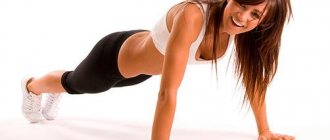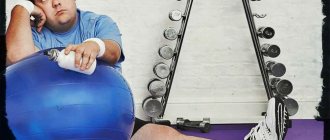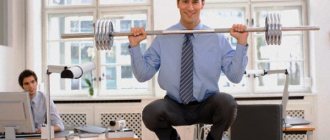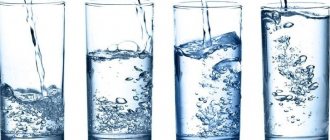Bodybuilder equipment[edit | edit code]
Clothes for bodybuilding
Clothes
. Workout clothes are a very important item and should never be taken lightly. Of course, a sports suit should be light and comfortable, keep warm well and not interfere with the skin’s breathing. It is best to train in clothes made of cotton or wool, or, in extreme cases, breathable synthetics. Clothing should be loose or stretchy enough to not restrict movement. The suit should be as open as possible - this not only allows the skin to breathe more fully, but also develops muscle sense.
Under no circumstances should the suit fit tightly to the body or tighten the skin. This interferes with normal blood circulation and promotes excessive accumulation of subcutaneous fat.
Women's bodybuilding clothing
And finally, clothes should always be clean. If you simply dry it, it will not absorb sweat intensively enough and will become an excellent environment for some pathogens of skin diseases. And the smell of old sweat can ruin the mood of both the athlete himself and those around him.
Shoes
. It is best to use comfortable, stable running shoes with good ankle support. This will help the athlete maintain balance and protect his feet from injury.
Gloves
. It is difficult to hold weight in sweaty palms, so it is better to train with gloves. It is better that they are made of washable material, since after a workout they are usually soaked with sweat.
Belt
. A wide belt around the waist is absolutely necessary when performing some exercises. It provides reliable protection and support for the lower back.
Towels
. One towel is needed to dry equipment after yourself. This is required by sports ethics. Who would like to train on a bench generously drenched in someone else's sweat? A second towel is needed to dry your face.
Water bottle
. During training you need to drink at least 1 liter of water. This is necessary to compensate for the loss of fluid in the body.
Player with headphones
. Many bodybuilders train to music; it not only motivates them, but also prevents them from being distracted from work.
Bodybuilding gloves.
They are fingerless gloves. Made from leather or leatherette. On the inside, in the place where the glove is in constant contact with the neck of the projectile, thicker leather inserts are sewn in to prevent rapid wear and tear of the gloves. The outer side is made in the form of a mesh, made of thinner material or has many holes for cooling. This is done so that the hand in the glove can “breathe” and not sweat so much. The use of gloves with a completely closed outside is not recommended. The gloves are secured to the hand with Velcro. Many glove models have an additional short leather band that wraps around the wrist. It functions as a wrist bandage and protects the wrists when using wrist straps.
After each workout, gloves should be turned inside out and dried in a cool place. Drying in the sun or heating devices is not allowed. This will lead to very rapid wear of the product and the leather in the folds will simply burst.
Bodybuilding gloves perform two main functions:
1. Prevent the bars or handles of exercise equipment from slipping out of your hands.
During training, the athlete's body (including the palms) sweats a lot. When performing the exercise, the apparatus may slip out of wet hands, which can lead to injury. Using gloves will eliminate this possibility. If for some reason you do not use gloves, rub your hands with chalk (every gym has it). Chalk will remove moisture from your palms and your hands will not be slippery.
2. Protect the skin of the palms from calluses.
This is especially true for beginner athletes and people not accustomed to physical labor. Many dumbbell and barbell bars are notched to reduce slipping. This can lead to large and quite painful calluses on the hands, especially for beginners. The appearance of such calluses will interfere with training and force you to stop until complete healing.
Training clothes[edit | edit code]
For training you need special shoes. Sneakers, in principle, are also suitable, but you need to choose models with absolutely flat soles and a hard back. Running shoes are not very suitable for these purposes, as they easily cause heel-to-toe roll. This is good for running, but when performing squats, there is a high risk of “falling forward” along with the barbell. It is better not to use slates, since they slide, thereby not providing sufficiently reliable support, and besides, they spread an unpleasant odor.
Wear a cotton T-shirt or tank top when training. Such clothes absorb sweat perfectly and do not irritate the body. Do not exercise without a T-shirt: not everyone will be pleased to see your sweaty torso, and besides, it is unhygienic. Avoid wearing jeans or other restrictive clothing that will hinder your ability to perform many exercises (such as squats); loose sweatpants or shorts are preferable.
Currently, high-tech synthetic fabrics have become popular, which in their properties are significantly superior to natural ones. A good example of this is the rash guard. It has an antimicrobial, antibacterial, compression, and sweat-wicking effect. Fights odor. After training, rinse with water without losing its properties. They are mainly used by wrestlers, since the fabric has heat-insulating properties and does not allow it to cool down during breaks.
Types of kits and their features
Literally, the name “bodybuilding” is translated as “building the body,” which is what athletes who choose this sport do. For a long time it was believed that such a hobby should only attract men, but later women also became interested in developing a beautiful, pumped up body. In order to carry out daily training, you need to choose the right clothes, which are represented by the following sets:
- For women;
- For men.
In addition, you need to understand what materials the sports wardrobe is made from. Only the best fabrics will provide the athlete with high results and comfort during training.
Women's
Experienced athletes who have reached heights in this area recommend using only cotton T-shirts and tank tops: they absorb sweat well and do not irritate the skin. As a rule, bodybuilding clothing can be divided into two categories: training and competition. The latter option is used only for demonstrations of a pumped up beautiful body on stage.
Women's training sets consist of the following items:
- T-shirt or T-shirt - depending on the degree of comfort, some girls choose T-shirts, the other half prefer T-shirts. One way or another, these components of the kits are made in bright colors. Good quality T-shirts do not change color after washing, which cannot be said about more affordable models. Some women who are not involved in bodybuilding purchase such products for everyday wear, as they absorb moisture well;
- Closed clothing similar to a rash guard - this intricate name is usually used to refer to closed golf made from elastic materials with the addition of synthetics. It fits perfectly on a girl’s slender figure and also protects against excessive sweating. This type of sportswear is suitable for outdoor bodybuilding, and if training takes place indoors, it is better to choose a rash guard with mesh inserts on the armpits and on the back;
- Top – the most popular type of clothing for women’s sports is the top – it gracefully emphasizes a girl’s figure without hindering her movement during bench presses and other exercises. The top is selected based on the size of the chest and the width of the back. Often the top is equipped with small foam inserts; its cup is soft, which does not cause discomfort during classes;
- Leggings - made of elastic materials, often their style is made with a high waistband, which allows the pants to be firmly fixed on the hips and waist. The colors are varied - from traditional black to colored options. It is better to choose products made of opaque fabric - this will not only protect the girl from unnecessary glances, but will also be proof of the quality and long service life of the leggings;
- Jacket - also made of synthetics with elastane admixtures. The cuffs are necessarily equipped with elastic to prevent discomfort during training. The collar of the jackets is made of knitwear, which allows you to protect the girl from the wind during outdoor competitions. A bright jacket will look attractive, especially if there are no prints on it;
- Bodysuits – available with or without cups. For bodybuilding, it is better to use a soft cup, avoiding bodysuits with supporting underwires;
- Shorts – made of lightweight fabric, which allows the body to “breathe”. In these shorts you can not only play sports, but also go for a walk.
The choice of clothing will depend on the climate and temperature conditions in the gym or outdoors.
Men's
The most common set of clothes for bodybuilding for men is a sports T-shirt and shorts. These two things will be the best option to conduct effective training. Some features of clothing for men:
- The jersey should be moisture-wicking to ensure maximum comfort during training;
- Clothes should not have many seams: the best choice is a seamless T-shirt made of dense but light fabric;
- The product must fit the athlete’s figure;
- The unique design of the product will allow you to stand out in the gym;
- It is better to choose a style of product similar to a wrestling shirt - it beautifully exposes the shoulder muscles, demonstrating all the work of the athlete;
- If there is no need to demonstrate the relief of the body, you can give preference to loose-fitting T-shirts;
- The main parameter when choosing a T-shirt will be the size of the chest - this is the largest indicator among bodybuilders;
- Instead of shorts, some men choose joggers - tight, long-length leggings;
- If a man’s choice fell on elongated pants, it is better to take narrower options;
- Shorts should be made of soft, light, but two-layer fabric;
- Double-layering is achieved by using mesh instead of lining;
- The waistband on shorts should be elastic.
Tops with long sleeves are also held in high esteem by athletes: they beautifully hug the contours of the body, emphasizing all the muscles. The sleeves on such products are made of raglan, which does not hinder movement when pressing.
Equipment[edit | edit code]
Special gloves will make exercise more enjoyable, especially if the skin on your hands is delicate and you quickly develop water calluses. If it starts to dry out and crack, use a moisturizer.
A weightlifting belt is essential when you start using heavy weights for exercises such as squats, deadlifts, overhead presses, etc. Using it will reduce the likelihood of injury.
If the room is hot, a small towel will come in handy. Always bring it with you to training - and you will not have problems with sweat flooding your eyes.
Shoes
Sports shoes (sneakers)
Sports shoes (sneakers)
In most gyms, doing bodybuilding barefoot is not only inconvenient, it is prohibited by the rules of etiquette. And there is logic in this. Because in the gym your legs will be in danger, for example, due to possible splinters, and besides, do not forget about flat feet, falling weights/dumbbells, sluggish practitioners, etc.
Therefore, my advice is to spare no expense and buy yourself high-quality sports shoes with hard soles.
The most important thing is that you feel comfortable in them.
Belt[edit | edit code]
Source:
“Bodybuilding.
Book trainer" .
Editor:
Oksana Usoltseva
Ed.
: Eksmo 2013
Belt
- This is a thick, wide belt with a reliable buckle. Worn on the lower back while performing exercises such as deadlifts, presses, squats, bent over rows. It maintains the spine in a stable position, exerting uniform pressure on the lateral surfaces of the torso, lower back and abdomen. The belt should be fastened tightly, but it should not interfere with proper breathing and movement technique. After completing a set (approach), remove the belt.
Choose a quality belt with a width of about 150 mm and made of durable material. Wider options can put pressure on the hips and core. Having suspended the load, the belt can be used for push-ups and pull-ups on the crossbar. To do this, leave it in a fastened but loose position and use a special hook to hang the load.
Weightlifting belt
In general, this is a fairly important attribute of the gym. It fixes the back and keeps the insides in place, and also serves as a complement to the working apparatus, for example, in the same uneven bars.
The belt itself is a wide leather strip with a thickening at the back to secure the back. More often
used in heavy basic exercises, they are also quite traumatic - deadlifts, squats, standing presses, etc.
I often notice how people in my gym constantly walk around with a belt on, I don’t know why they do this, but the fact that they don’t understand that it’s very harmful is 100%.
Why is it harmful, you ask? Yes, because the stomach is constantly pinched, how can this be good? That's it - no way. .
Therefore, use the belt immediately before a heavy approach to a traumatic exercise or in addition to a working apparatus (on uneven bars, for example), but after completing the approach, be sure to either loosen the belt or, even better, remove it!!!
Most often, gyms already have a couple or three of these belts, but if they still don’t, sports stores have a wide selection of similar belts; the most important thing is to choose your size.
Water
I don’t know what to write here.. Water is simply necessary during training, because dry mouth will not bring you anything good. On the contrary, it can only cause harm; there have been cases of dizziness, nausea, and, moreover, even death is possible. Therefore, water, as I have already written, is vital.
Wristbands and elastic bandages[edit | edit code]
Wristbands
and
elastic bandages
are worn or wrapped around the wrists (sometimes on the elbows) during various presses, squats, and pushes.
They stabilize the hand, protect against sprains and create a massage effect. Fixed tightly on the wrist.
To avoid blocking the blood flow, they are removed during rest between sets, just like a belt. The length of the wristbands is from 30 to 60 cm.
Knee wraps perform the same function as wristbands, but for the knee joints. They are made from the same material, but are longer.
In some strength sports (powerlifting, strongman), very hard knee wraps are an integral part of the training process and competitions. They serve as insurance against injury and aid in lifting weights.
Caliper[edit | edit code]
Caliper
- a support sleeve sewn from elastic fabric, which is used to retain heat in the articular and periarticular area and has a massage effect. It is most often used to recover from injuries to the ankle, elbow and knee joints.
Wrist straps are sometimes used when lifting heavy objects. These belts, about 50 mm wide, made of dense, non-elastic material, are used to hold a dumbbell or barbell in your hands when the strength of your forearms and hands is not enough.
Gloves[edit | edit code]
Gloves
as a piece of equipment they perform rather an aesthetic function. They protect your hands from calluses that will inevitably appear on your palms from constant contact with the barbell or dumbbells. They also have a negative side. Gloves do not allow full contact with the weight being lifted, which reduces control over the exercise, which can affect safety. It is no coincidence that gloves are not used when lifting heavy weights in related strength sports (powerlifting, weightlifting, strongman).
Read more:
Sport gloves
Training diary[edit | edit code]
The training diary should include all training days of the cycle and planned workouts with the expected weight of the equipment, as well as records of the actual workouts performed with the number of sets, repetitions and weight lifted. Note any changes in your well-being. Once every few weeks, write down your own weight and anthropometric data (waist, chest, biceps, etc.) in your training diary.
A more effective means of control is photography.
After all, it is important to you how others evaluate you, who do not think about your weight and waist circumference. All this will help you analyze and make plans for the future, making every workout effective and interesting.
Sports bag
Sport bags
In general, any container that is convenient for you will do (bag, briefcase, whatever is convenient for you). Of course, a sports bag is preferable, but this is not necessary, for example, I have been training for quite a long time and go with a backpack (because it’s more convenient for me), the choice is yours in any case.
Sports bags are very good, comfortable (there is a strap to hang it on your shoulder, there are also side pockets which is also very convenient, you can throw water or something else in there...at your discretion), spacious (lots of space for the same things, sneakers, water, shorts/pants, etc.).











